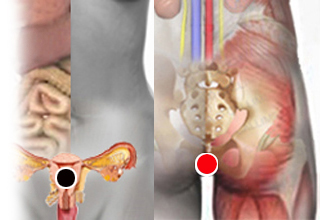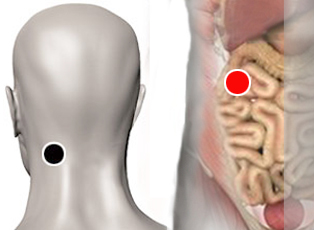Food Intolerances
Pair
uterus - rectum

Introduction:
The difference between allergies and food intolerances is that the body's reaction and symptoms are different. Allergies commonly manifest with alterations in the skin, irritation, respiratory tract and generalized inflammatory processes. Food intolerances mainly affect the digestive process.
According to the allopathy the intolerance to diverse foods obeys, mainly to genetic factors. Age also influences the appearance of this type of affections, for example in the case of lactose intolerance, the lactase enzyme decreases as the person's age increases. In the case of intolerance to gluten, genetic markers may exist, without the person having the symptoms. The pathogens add one more factor to the equation as Dr. Isaac Goiz Duran has discovered.
Lactose intolerance:
Caused by the inability to digest lactose (protein present in milk and its derivatives). The person suffers from digestive disorders such as inflammation, colic, when consuming dairy products. It is important to note that the older a person is the more likely they are to develop this condition, so it is suggested that adults reduce or eliminate dairy consumption. There have also been marked differences between different human races.
Proteus Mirabilis and Clostridium Perfringens are the main pathogens that detonate this condition.
Gluten Intolerance:
Also known as Celiac Disease or (gluten-sensitive enteropathy). Gluten is a group of proteins contained in some cereals, mainly in Oats, Wheat, Barley and Rye, has a elastic consistency so this texture is appreciated in developing various types of food.
Gluten triggers the immune system to atack the small intestine with devastating efects, as it destroys tissues, preventing the absorption of various nutrients and this brings multiple consequences: weight loss, lack of appetite (Anorexy), fatigue, nausea, vomiting, diarrhea, abdominal distension and pain, loss of body mass, growth retardation, bloating, abdominal pains, alterations of character (irritability, apathy, depression, introspection, sadness). It can also present atypical symptoms, which makes its diagnosis difficult. It can be confused with other diseases. It is estimated that 70% of people who suffer from it have not been diagnosed correctly.
If not diagnosed in youth it can cause other diseases as:
- Liver diseases: Hepatitis, Cirrhosis
- Thyroid dysfunction
- Chronic fatigue syndrome
- Dermatitis Herpetiformis
- Gluten Ataxia
- Idiopathic Cardiomyopathy
- Idiopathic Arthritis
- Colitis (various types)
- Peripheryal Neuropathy
- Sjogren Syndrome
- Type I Diabetes
- Unexplained infertility
Allopathic medicine has no cure against this condition, the only solution is to completely suspend the intake of gluten, observing very well the foods that are ingested.
On the other hand, the biomagnetic pair has found that the pairs that most often are detonating factors of this condition are: Staphylococcus Aureus (+), Staphylococcus Aureus (-) and Vellonela.
This brings us to the theory that a healthy gut microbiota must be maintained, since bacteria help break down the gluten protein. The infection by other pathogens alters this balance, being able to be the detonating factor of the disease .
Oilseed Intolerance:
Pairs
mastoids - duodenum
occipital - duodenum

The oilseeds are also known as nuts that include: nuts, almonds, pistachios, peanuts, hazelnut, among others. Some consider that these foods cause allergic reactions, rather than food intolerances, nuts are the most often can cause mild or severe disorders such as an anaphylactic reaction. It is recommended to be very careful with the food you eat and read the labels.
In this section: